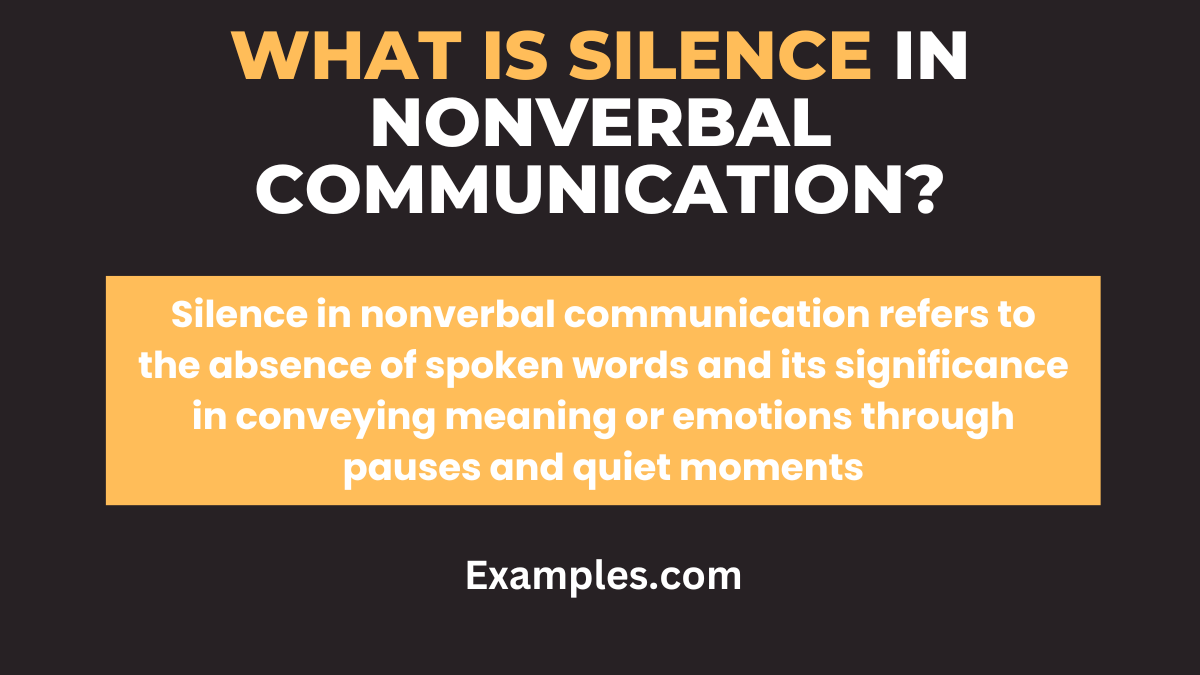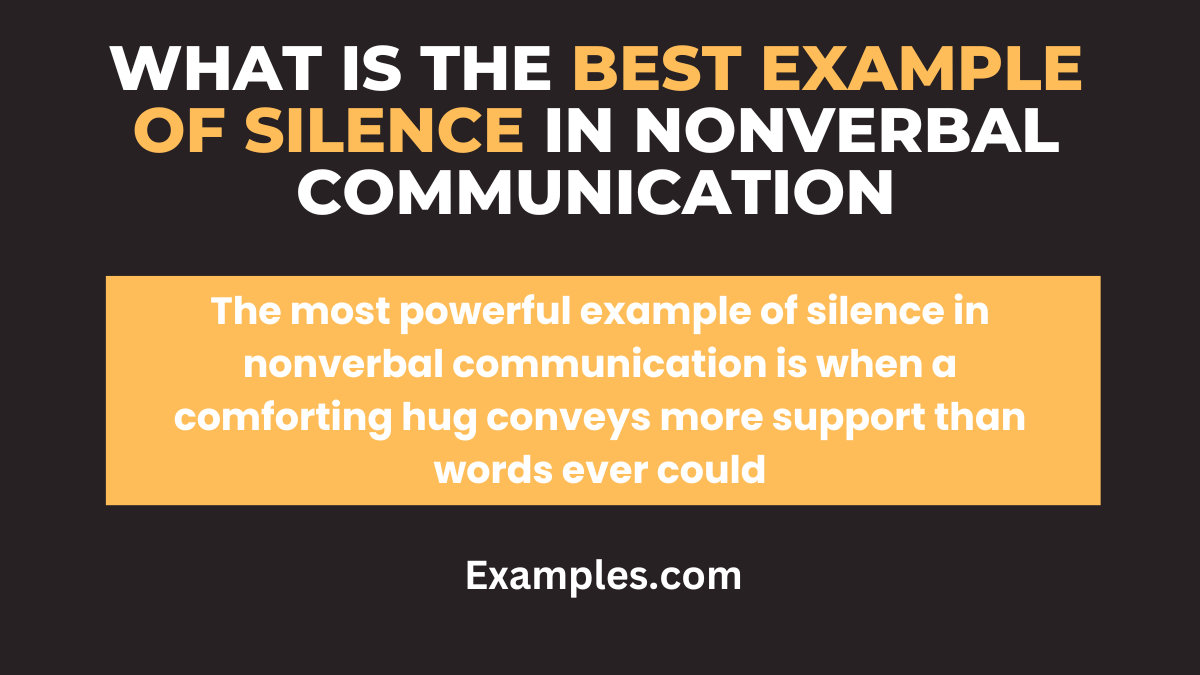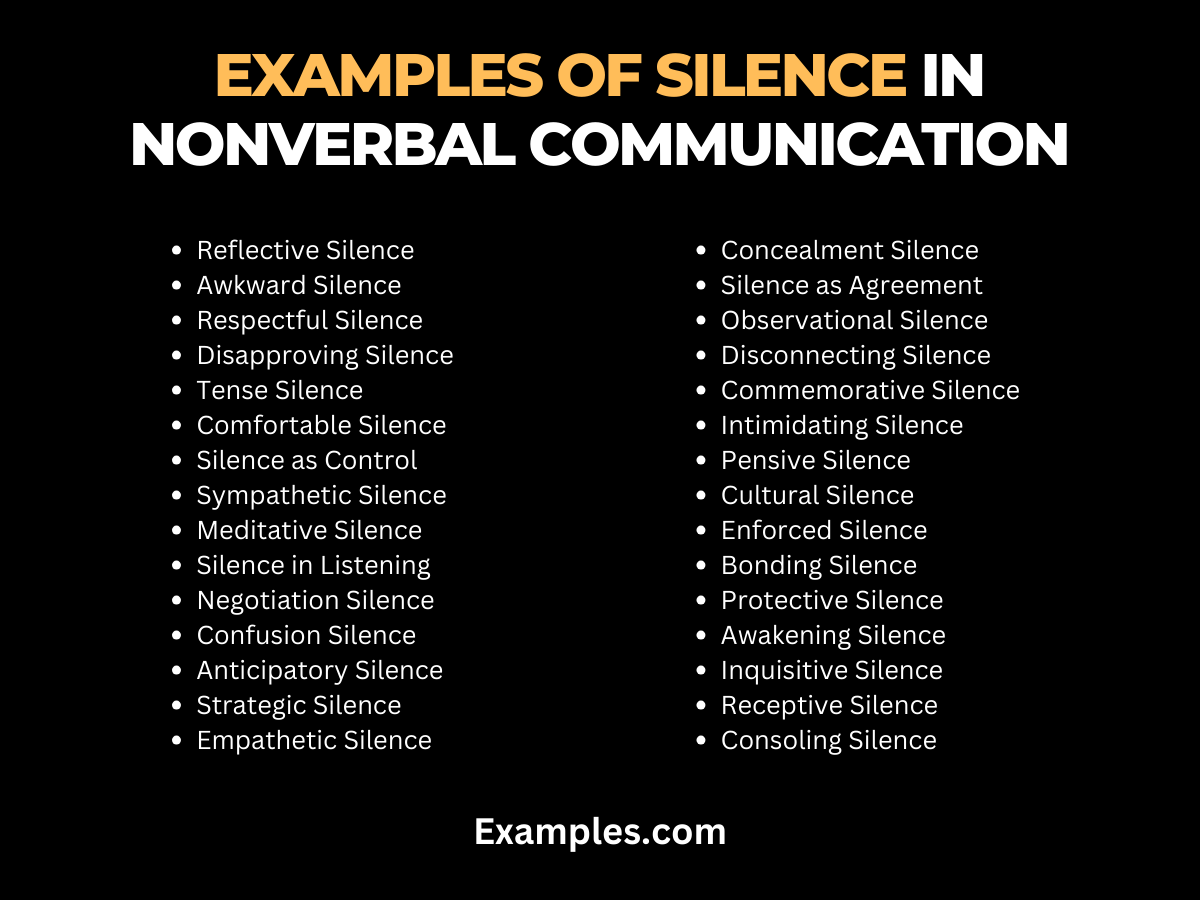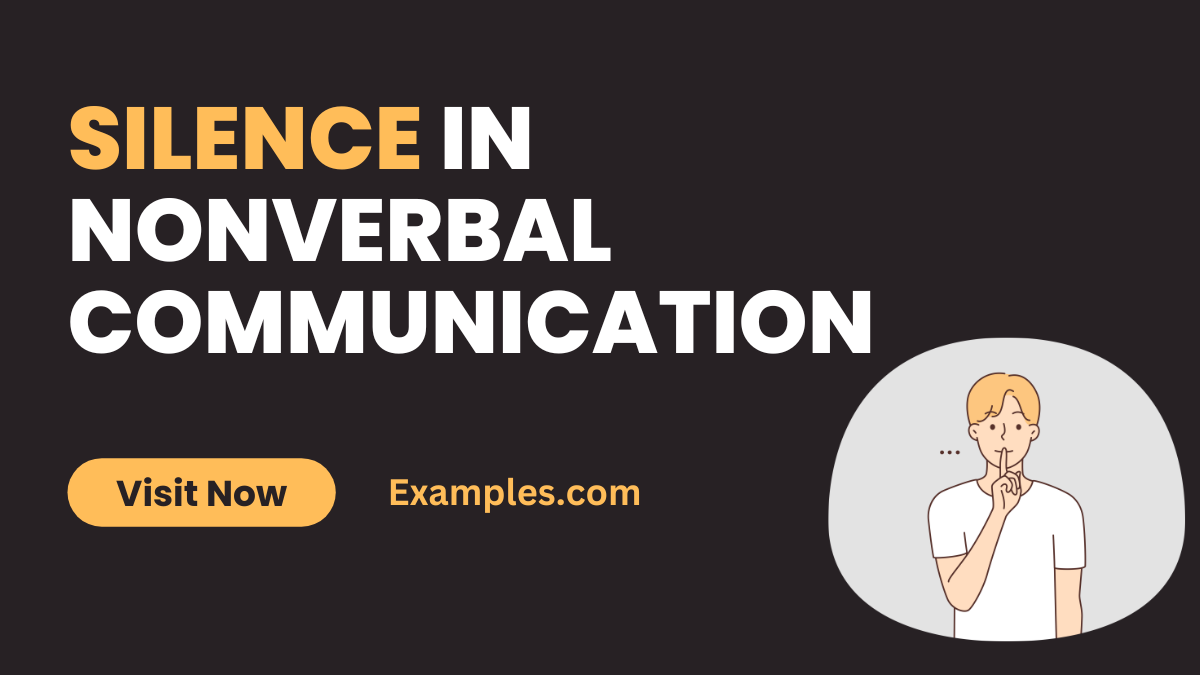29+ Silence in Nonverbal Communication Examples
Understanding Silence in Nonverbal Communication unveils a profound layer of human interaction. This guide explores the often overlooked but powerful aspect of communication, where silence speaks volumes. From the subtle pauses in a conversation to the impactful moments of quiet, silence is a significant component of nonverbal communication, offering insights into emotions, thoughts, and intentions.
What is Silence in Nonverbal Communication?

Silence, in the context of nonverbal communication, is the absence of spoken words, yet it communicates much more than words can convey. It’s a form of nonverbal expression that can convey a variety of messages, depending on the context and the relationship between the people involved. Silence can be intentional or unintentional, and it can communicate agreement, disagreement, contemplation, discomfort, or a range of other states and emotions.
What is the Best Example of Silence in Nonverbal Communication?

Silence, often overlooked, is a powerful aspect of nonverbal communication. It serves as a versatile tool, conveying a range of emotions and messages without a single word. The best example of silence in nonverbal communication can be observed in a pause during a conversation. This pause, whether intentional or accidental, creates a space for reflection, emphasis, and interpretation. It can signal agreement, disagreement, shock, contemplation, or a myriad of other emotions and responses. In professional settings, strategic silences can underscore the importance of a point, indicate the need for thought, or demonstrate patience and respect for others’ opinions.
30 Examples of Silence in Nonverbal Communication

Silence, often overlooked, plays a crucial role in Nonverbal Communication. It’s not merely the absence of speech; silence can communicate a multitude of emotions and messages. This form of communication becomes especially significant in contexts where words fall short or when they might exacerbate a situation. Understanding the nuances of silence is vital in interpreting nonverbal cues accurately.
- Reflective Silence: In a heated discussion, a pause before responding can indicate that a person is processing information, reflecting on what’s been said, or carefully considering their response. This reflective silence is strategic and shows thoughtfulness.
- Awkward Silence: Often occurring in social interactions, awkward silence can indicate discomfort, anxiety, or unfamiliarity between participants. It’s a powerful indicator of the emotional climate in a room.
- Respectful Silence: In cultural ceremonies or solemn occasions, silence is a form of respect. It signifies reverence and solemnity, showing honor to the situation or individuals involved.
- Disapproving Silence: When someone disapproves or disagrees with something but chooses not to verbalize their thoughts, their silence can be a potent form of nonverbal disagreement.
- Tense Silence: This type of silence can occur during conflicts or in high-stress situations, indicating anger, frustration, or tension. It’s a nonverbal way of expressing strong emotions without using words.
- Comfortable Silence: Among close friends or partners, silence can be comfortable and indicates a deep understanding and comfort with each other’s presence, where words are unnecessary.
- Silence as Control: In power dynamics, silence can be used to control a conversation or situation, often leaving the other party uncertain or uneasy. It can be a tactic to dominate or manipulate the flow of communication.
- Sympathetic Silence: In times of grief or sadness, silence can be a form of sympathy. It shows support and understanding for someone’s pain, where words may be inadequate.
- Meditative Silence: In spiritual or meditative practices, silence is used to calm the mind, focus thoughts, and connect with a deeper sense of self or spirituality.
- Silence in Listening: Active listening often involves periods of silence, indicating that one is fully engaged and processing what the other person is saying, showing empathy and understanding.

- Negotiation Silence: In negotiations, silence can be a tactical tool, creating a sense of pressure or prompting the other party to speak more, reveal information, or reconsider their stance.
- Confusion Silence: When someone is confused or doesn’t understand something, they might pause in silence, signaling their need for clarification or more information.
- Anticipatory Silence: Before a significant announcement or moment, anticipatory silence can build tension or excitement, emphasizing the importance of what’s to come.
- Strategic Silence: In debates or discussions, a well-timed silence can be a strategic move to allow the implications of a statement to sink in, enhancing its impact.
- Empathetic Silence: When words cannot adequately express empathy, silence can be a powerful tool to convey understanding and shared emotions.
- Concealment Silence: Sometimes, silence is used to conceal thoughts, feelings, or intentions, acting as a protective barrier for personal emotions or privacy.
- Silence as Agreement: In some contexts, silence can imply agreement or consent, especially if a response is expected but not given.
- Observational Silence: Remaining silent to observe and analyze a situation or conversation can provide valuable insights and understanding without immediate participation.
- Disconnecting Silence: This type of silence signifies a withdrawal or disconnection from the conversation, often indicating a lack of interest, disdain, or the desire to end the interaction.
- Commemorative Silence: In remembrance of significant events or individuals, a moment of silence honors and acknowledges loss or respect in a collective, solemn manner.
- Intimidating Silence: Used in power plays, this silence aims to intimidate or unsettle the other party, often in hierarchical or confrontational situations.
- Pensive Silence: Reflecting deep thought or contemplation, this silence often accompanies moments of decision-making or profound realizations.
- Cultural Silence: Varies across cultures; in some, silence is a sign of wisdom and thoughtfulness, while in others, it might be seen as agreement or disapproval.
- Enforced Silence: Imposed silence, whether in a classroom, courtroom, or other formal settings, serves to maintain order and respect for the process at hand.
- Bonding Silence: Shared silence in a group can strengthen bonds, creating a sense of unity and shared experience without the need for words.
- Protective Silence: Used to protect oneself or others from harm, this silence can be a form of defense or safeguarding personal or sensitive information.
- Awakening Silence: In spiritual or self-awareness contexts, silence can lead to moments of awakening or realization, providing clarity and insight.

- Inquisitive Silence: Waiting in silence after asking a question can put the onus on the other person to respond, serving as a prompt for further information or honesty.
- Receptive Silence: Indicates openness and willingness to listen, creating a safe space for others to express themselves freely.
- Consoling Silence: In times of distress, silence can be a comforting presence, offering solace and support when words may fall short.
What are the Advantages and Disadvantages of Silence in Nonverbal Communication?
| Advantages | Disadvantages |
|---|---|
| Enhances Reflection: Silence in nonverbal communication allows individuals to reflect and think deeply before responding, leading to more thoughtful and considered interactions. | Can Create Misunderstandings: Without verbal cues, silence can be misinterpreted, leading to misunderstandings or assumptions about the other person’s thoughts or feelings. |
| Increases Impact: In certain scenarios, silence can be more powerful than words. It can emphasize a point or convey seriousness, often used in dramatic moments for effect. | Can Feel Uncomfortable: Prolonged silence can create discomfort or awkwardness in conversations, especially in cultures where constant communication is the norm. |
| Facilitates Emotional Control: It gives people time to manage their emotions and respond calmly, particularly in tense or challenging situations. | Hinders Expressiveness: Silence limits the expression of emotions or thoughts that might be more effectively communicated through words or other forms of nonverbal communication. |
| Promotes Active Listening: Encourages active listening, as participants focus more on nonverbal cues like body language and facial expressions to understand the message. | Reduces Clarity: In some contexts, silence can lead to a lack of clarity, making it difficult to understand the intention or meaning behind the communication. |
| Culturally Respectful: In many cultures, silence is a sign of respect, showing attentiveness and consideration to the speaker. | Cultural Misinterpretation: The meaning of silence varies across cultures; what is considered respectful in one culture might be seen as disinterest or rudeness in another. |
Importance of Silence in Nonverbal Communication
- Conveys Emotional States: Silence can express a multitude of emotions, from anger and frustration to acceptance and calmness. It often conveys feelings that words might fail to express.
- Enhances Listening: By maintaining silence, individuals show attentiveness and respect towards the speaker, facilitating deeper understanding and empathy.
- Reflects Thoughtfulness: Pauses in speech allow for reflection and consideration, indicating that a person is thinking deeply about the conversation or the subject at hand.
- Signifies Discomfort or Disagreement: In some situations, silence can be a sign of discomfort, disapproval, or disagreement, offering cues to the underlying tension in a conversation.
- Strengthens Communication: Strategic use of silence can enhance verbal communication, giving more weight to the spoken words and allowing for effective communication.
- Cultural Significance: In various cultures, silence is a sign of respect, wisdom, or social etiquette, playing a crucial role in interpersonal interactions.
- Regulates the Flow of Conversation: Silence is often used to regulate the pace and flow of a conversation, signaling a change in topic or the end of a discussion.
Silence in Nonverbal Communication for Students
For students, mastering the use of silence in nonverbal communication can be particularly beneficial. Here are some points and detailed explanations:
- In Group Discussions: Using strategic silences can demonstrate thoughtfulness and respect for others’ opinions.
- During Presentations: Pausing at key moments can help emphasize important points and engage the audience more effectively.
- In Conflict Resolution: Silence can be a tool for de-escalating conflicts. It allows time for emotions to settle and for more rational thinking to take over.
- Enhancing Learning: Students who learn to appreciate silence can enhance their concentration and comprehension during lectures and studies.
- Cultural Sensitivity: Understanding the role of silence in different cultures can improve cross-cultural communication, an essential skill in today’s globalized world.
- Personal Development: Students can use silence to reflect on their goals, progress, and areas for improvement, fostering self-awareness and personal growth.
How to use Silence in Nonverbal Communication?
1. To Emphasize a Point
- A well-timed pause after a significant statement can highlight its importance, allowing the audience to absorb and reflect on the message.
2. To Encourage Participation
- In group discussions or meetings, silence can invite others to speak, promoting inclusivity and diverse perspectives.
3. To Control the Pace of Conversation
- Using silence can slow down a conversation, providing time for more thoughtful and considered responses.
4. To Create Emotional Impact
- In emotional or sensitive contexts, silence can be more eloquent than words, conveying empathy, respect, or shared sorrow.
5. To Indicate Disagreement or Disapproval
- A deliberate pause can subtly express disagreement or disapproval, allowing the sender to communicate their stance without confrontation.
6. To Build Suspense or Interest
- In storytelling or presentations, strategic silences can build anticipation, keeping the audience engaged and attentive.
7. For Self-Reflection
- Silence allows individuals to process their thoughts and emotions, leading to more mindful and intentional communication.
8. To Respect Cultural Norms
- In many cultures, silence is a sign of respect, wisdom, or social awareness, and understanding these nuances is crucial in global communication.
Incorporating silence effectively in nonverbal communication requires sensitivity to context, audience, and cultural norms. It’s a skill that enhances types of nonverbal communication, offering a nuanced and powerful means of expression beyond words.
Tips for Silence in Nonverbal Communication
Silence, often overlooked, plays a crucial role in nonverbal communication. It’s a powerful tool that, when used effectively, can communicate a range of emotions and intentions. Understanding and mastering the art of silence can enhance interpersonal communication significantly. Here are some tips for using silence effectively in nonverbal communication:
- Creating Emphasis: Silence can be used to emphasize a point. After making an important statement, a pause can allow the message to resonate more deeply with the listener.
- Encouraging Thought and Reflection: In conversations, a pause can prompt reflection or deeper thinking about the subject at hand.
- Regulating Conversations: Strategic silences can help in managing the flow of conversation, giving others a chance to speak or signaling a change in topic.
- Expressing Emotions: Sometimes, silence can convey emotions more powerfully than words – be it contemplation, sadness, or disappointment.
- Building Suspense or Interest: In storytelling or presentations, silence can build anticipation or highlight a critical moment.
- Non-Verbal Listening: Active listening isn’t just about hearing words; it’s about noticing the silences and understanding their meaning in context.
For further in-depth understanding and research on the nuances of silence in nonverbal communication, consider exploring these reputable and authoritative external links. First, Harvard University’s Program on Negotiation offers insightful articles and resources that delve into the strategic use of silence in communication, available at Harvard PON. Additionally, Psychology Today, a well-known platform for psychological insights, provides a comprehensive perspective on nonverbal communication, including the role of silence, accessible at Psychology Today. Lastly, the National Communication Association, a leading organization in the field, offers valuable resources and articles that can be found at NCA, presenting academic and practical viewpoints on this topic. These links are chosen for their high domain authority, relevance, and the valuable, educational content they provide on the subject.



